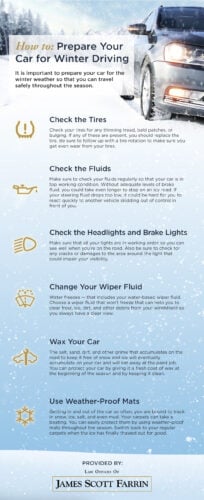Winter Car Prep with The Advocates
For some, winter driving is second nature—as much a part of life as driving in the summertime. Others, especially those traveling for the holidays, or those who have recently moved to an area with a colder climate, may find themselves struggling as cold weather approaches.
At The Advocates, we take winter car prep seriously. We want everyone to be as safe as possible when winter weather hits.
Take the following steps to ensure your car is ready for winter driving conditions.
Check Your Tires
Make sure your tire tread isn’t too worn. Balding tires make it easier to skid, especially when roads are icy. You should also be sure to rotate your tires regularly to prevent them from wearing unevenly.
Check your tire pressure regularly throughout the winter season. You may find yourself needing to add air to your tires more frequently during winter, as large changes in temperature can cause pressure loss. You can find the appropriate
 pressure level for your tires on the inside of your driver’s side door.
pressure level for your tires on the inside of your driver’s side door.
If you live in a particularly snowy area, consider purchasing snow tires. They can help you keep traction on slippery roads. It’s important to note, however, that winter tires can worsen your fuel economy, so swap them out for all-season tires after the winter months end.
Check Your Windshield Wiper Blades and Washer Fluid
Take a look at the blades on your windshield wipers to ensure they aren’t worn or dried out. If you find yourself in a winter storm with old wiper blades, your visibility may be seriously impacted.
You may want to install winter wiper blades if you live in an area with very cold temperatures. The rubber on these blades prevents ice from forming on them.
Refill your windshield wiper fluid regularly. You can find washer fluid for winter conditions at just about any auto shop. Winter washer fluid has deicer that will keep it from freezing. You can also add washer fluid antifreeze to the reservoir.
While you’re at it, make sure your rear window defroster is working. Ice buildup on your rear window can make it impossible to see what’s behind you.
Keep Up with Oil Changes
This is something you should be doing all year round, but it can be especially important in the winter months. The last thing you want is to break down in the middle of a snowstorm.
Depending on where you live, it may also be a good idea to use winter-grade oil in your car during the coldest months. Your mechanic can help you determine which type of oil is best for your car.
Take a Look Under the Hood
Cold temperatures can affect your car battery’s life, so it’s a good idea to test its voltage periodically. Check your battery posts and terminals for corrosion, as buildup can also impact your battery’s ability to function correctly.
While you’ve got the hood up, check your coolant. Coolant can protect your engine from freezing, prevent corrosion, and lubricate the water pump in order to keep your cooling system in good working order.
If you don’t feel comfortable maintaining these systems on your own, consider taking your car into a shop for a tune-up. A mechanic can address several potential issues in one visit.
Check Your Exterior Lights
Winter driving conditions can significantly decrease visibility. It’s important that you have working headlights, taillights, and brake lights—both so you can see your surroundings and so other drivers can see you.
If you have any burnt-out bulbs, replace them as soon as possible. Clean the light lenses too; foggy lenses can reduce light output by as much as 80%, according to AAA.
Fill Up Your Gas Tank
Running out of fuel is never fun, but this is especially true in subfreezing temperatures. Additionally, a full tank can prevent your gas line from freezing. Our advice? Keep your car at no less than a half-tank throughout the winter.
Stock Your Car with an Emergency Kit
Hopefully you already have a car emergency kit, with items like jumper cables, a jack, and a first aid kit. It’s a good idea to add a few winter-specific items to the kit as cold weather rolls around.
Consider keeping your car stocked with the following:
- Ice scraper and snow brush
- Flashlight and batteries
- Warm clothing and a blanket
- Kitty litter or sand (these can help with traction if you get stuck)
- Snow shovel (you can find portable shovels online or in some auto shops)
- Cell phone and charger
